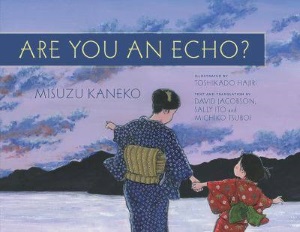2018 School Spending Survey Report
Review of Are You an Echo?: The Lost Poetry of Misuzu Kaneko
Are You an Echo?: The Lost Poetry of Misuzu Kaneko
poems by Misuzu Kaneko; narrative by David Jacobson; illus.
 Are You an Echo?: The Lost Poetry of Misuzu Kaneko
Are You an Echo?: The Lost Poetry of Misuzu Kanekopoems by Misuzu Kaneko; narrative by David Jacobson; illus. by Toshikado Hajiri; trans. from the Japanese by Sally Ito and Michiko Tsuboi
Primary, Intermediate, Middle School Chin Music Press 64 pp.
9/16 978-1-634905-962-6 $19.50
Part biography, part poetry collection, this book introduces Japanese children’s poet Misuzu Kaneko (1903–1930). The first half features a biographical narrative about Kaneko (interspersed with ten of her poems), who, at twenty, worked in her family’s bookstore and wrote popular children’s poetry. The rest of her brief life is grim: Kaneko committed suicide after her husband gave her “a disease that caused her great pain,” forced her to stop writing poetry, and then threatened to take their young daughter away after they divorced. Jacobson conveys the facts plainly and sensitively (“So she decided to end her life. She was only twenty-six years old”) and follows the tragic news with the poem “Cocoon and Grave,” which ends, “A person enters a grave — / that dark, lonely grave. // But the good person / will grow wings, become an angel / and fly away.” In 1982 all of Kaneko’s 512 (mostly unpublished) poems were discovered and published to great acclaim. The title poem then played a part in Japan’s rebuilding after the tsunami in 2011, when it was used in a public service announcement that helped draw a million volunteers to the affected area—an uplifting note on which to conclude. Young poetry readers can enjoy the second half on its own, if they like: fifteen poems, printed in English first, then Japanese. These are child-centered, full of empathy, and sensitive, with many poems personifying animals or inanimate objects — something children do constantly. The type is often difficult to read against the full-page art, but Hajiri’s illustrations capture time and place in addition to rendering delicate close-up views of the world from a young child’s point of view. An informative author’s note and a fascinating note from the translators are appended.
From the January/February 2017 issue of The Horn Book Magazine.
RECOMMENDED
ALREADY A SUBSCRIBER? LOG IN
We are currently offering this content for free. Sign up now to activate your personal profile, where you can save articles for future viewing.






Add Comment :-
Be the first reader to comment.
Comment Policy:
Comment should not be empty !!!